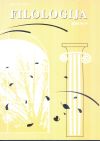XIX a. didaktinė ir XX a. 5-6 dešimtmečių normatyvinė lietuvių apysaka: teksto struktūros panašumai
Didactic and Normative Lithuanian Novella: Similarities of Textual Structure
Author(s): Irena Klimašauskienė, Džiuljeta MaskuliūnienėSubject(s): Language and Literature Studies
Published by: VšĮ Šiaulių universiteto leidykla
Keywords: didactic prose; normative novella of post-war period; textual structure; model of a didactic text; rhetoric of an example; collective character; thesis-like narration; contrastive images
Summary/Abstract: Though there is a big distance between didactic prose of the 3rd–8th decades of the 19th century and normative Lithuanian prose of the 5th–6th decades of the 20th century as well as the changed situation of literary communication, social and political context, however, some similar features can be found in these texts. A declarative character, relatively simple, elementary organisation of a text and stereotyped poetics are determined by author’s didactic educative or ideological party-spirit engagement: the creators of Lithuanian didactic prose in the 19th century undertake a role of a Christian Teacher, and the authors of normative prose of the 5th–6th decades of the 20th century undertake a role of an ideological speaking-trumpet. Two novellas – "Aplankymas seniuko dėl brolių žemaičių ir lietuvių… aprašytas" (1853) by Petras Gomaliauskis and "Audronė Narmontaitė" (1952) by Jonas Marcinkevičius – are compared in the present article. The following similarities of textual structure and poetics are discussed: 1) the model of novellas; 2) the rhetoric of an example, the opposition of positive and negative character; 3) contrastive depiction of settings; 4) thesis-like narration (open moralisation, inserts of declarative cries etc.); 5) collective character; 6) permanent emblematic images; 7) the actualisation of particular themes and problems (the idea of temperance, the idea of establishment of kolkhozes etc.). The texts, which are created for didactic and ideological communication, speak to the addressee in a placard-like and normative way. The aesthetical dimension of such works is rather problematic.
Journal: Filologija
- Issue Year: 2004
- Issue No: 09
- Page Range: 85-89
- Page Count: 5
- Language: Lithuanian

